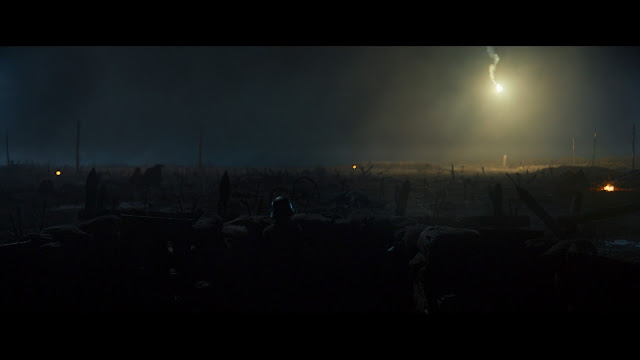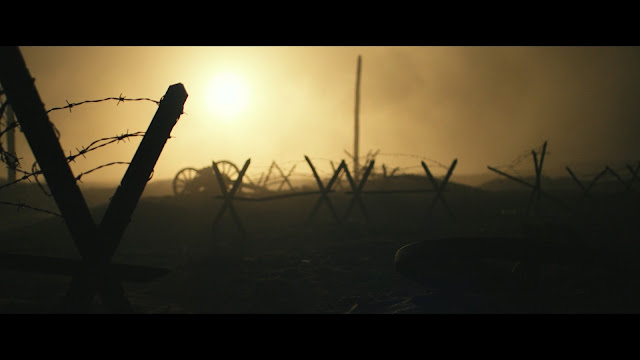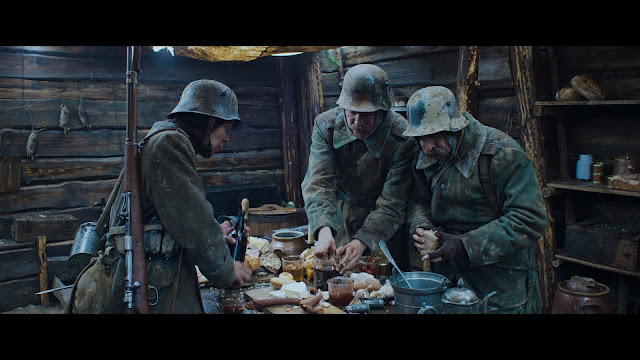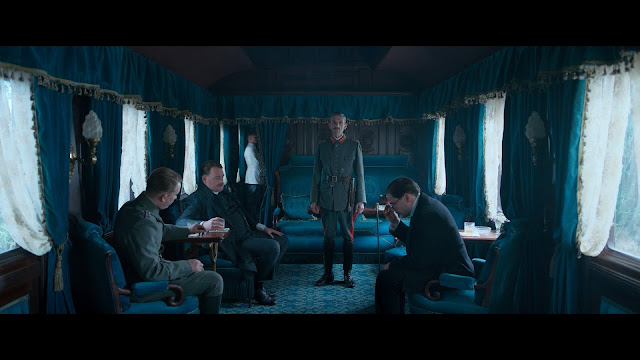MARTIN (1977)
Label: Second Sight Films
Region Code: Region-Free
Rating: Cert. 18
Duration: 95 Minutes
Audio: English DTS-HD MA 1.0 Mono, DTS-HD MA 2.0 Stereo, DTS-HD MA 5.1 with Optional English Subtitles
Video: 2160p Ultra HD Fullscreen (1.33:1)
Director: George A. Romero
Cast: John Amplas, Christine Forrest, Tom Savini, Lincoln Maazel
In George A. Romero's sublime subversion of vampire lore Martin (1977) the titular blood-drinker, played by by John Amplas (Dawn of the Dead), is a troubled teen who believes he’s an 84 year-old vampire. At the start of the film he arrives in a small Pennsylvania town by train to live with his much older cousin, the ultra-religious Cuda (Lincoln Maazel, The Amusement Park), who vows to save his vampire cousin's immortal soul before killing him. Also living in the home is Cuda's orphaned grandaughter (Christine Forrest, Dawn of the Dead, and future wife if the director), who is not fanatical like her grandfather, she doesn't believe Martin to be a vampire, but a deeply disturbed young man in need of psychiatric help. Cuda provides Martin with a room in his home but the old man in far from hospitable, festooning the doorways with wreathes of garlic, and never missing an opportunity to yell "Nosferatu!" at him. Cuda also threatens that if Martin kills anyone in the town of Braddock that he will dispatch him with a wooden stake without first saving his soul.
It's odd hiven the old man's hate for him that Martin begins working for Cuda at his butcher shop, which requires that he deliver groceries to customers. On one of his deliveries he meets a lonely housewife named Abbie Santini (Elyane Nadeau), who takes a liking to the awkward young man, hiring him to do odd jobs around her home while her husband is away. Eventually she makes a pass at the awkward Martin, but being a virgin he is hesitant to be seduced, but reciprocates and is pleased to find that sexual release seems to curb his blood thirst. Momentarily things seem to be getting better for Martin, but Cuda's relentless reinforcement that he is evil incarnate leaves the him unable to escape his predetermined status as a monster.
Make no mistake about it though, Martin is not an anti-hero, he's not a misunderstood teen rebel - he's a murderous blood-drinker who armed with syringes full of anesthetic and razor blades incapacitated and exsanguinates multiple victims. The film opens with a true banger, a chilling encounter on the train headed to Pittsburg with Martin stalking a young woman (Francine Middleton, Sweet Savior aka The Love- Thrill Murders), drugging her inside her sleeper car, slashing her wrists and drinking her blood, then staging it to look like a suicide. The staged suicide becomes the teens macabre modus operandi, and funnily enough, it's a legit suicide that proves to be his ultimate undoing. Later we witness Martin embarking on a home invasion in the suburbs where he has tracked a regular customer from the butcher shop, expecting her to be home alone as her husband's away on business, but instead he finds the horny housewife in bed with a lover. This puts a wrinkle in his attack plan but he improvises and makes due, draining the unlucky lothario after stabbing him in neck with a stick, but sparing the woman.
Is Martin truly a vampire? Certainly not in the traditional sense, he has the blood cravings but there are no fangs, aversion to crucifixes, garlic or sunlight, he has no mesmerizing powers, nore supernatural allure, and he has a reflection - but he does kill for human blood, he's a very reality-based monster. He is most likely just be a confused and deeply disturbed young man who has been raised to believe he's a Nosferatu, brainwashed from birth to become a monster. Martin himself says at one point after taunting his cousin by donning a corny vampire cloak, pale face paint and plastic fangs, "There's no real magic...ever." The earlier part of his life is not explored in depth, but we do get monochrome flashbacks to what looks to be the 1920's, but are these remembered reality or planted memories reinforced by years of being told he's a monster by a family with a shared mental illness?
Throughout the film Martin anonymously calls into a local radio show where he is dubbed "The Count", during the calls he attempts to dispel the modern cinematic myths of the vampire, and becomes something of a sensation on the radio, which also provides an eerie eulogies to the films final moments.
Romero's Martin is a truly singular vision of vampiric violence, an interesting character study of a blood-hungry outsider-teen set to the backdrop of a small crumbling community. It was Romero personal favorite of his own films and while it failed to find an audience with it's anemic initial theatrical showing it's become a full-blooded cult classic, especially for Romero fans and those excited by non-traditional vampire lore. The film also features Romero himself as a priest and also feature special make-up FX legend Tom Savini in small roll. It was also the first time Savini did special effects for Romero with some low-budget but effective exsanguinations, including a visceral wooden stake to the chest.
Audio/Video: Martin (1977) makes it's worldwide 4K UHD debut from Second Sight Film in 2160p UHD, framed in the original 1.33:1 fullscreen aspect ratio. As the original 16mm reversal stock elements no longer seem to exist this new restoration is sourced from a 35mm dupe negative, supervised and approved by director of photography Michael Gornick. The image is authentically grainy and doesn't have the same depth and clarity of a 35mm original negative element scanned in 4K, but with realistic expectations checked it's a night and day comparison to previous DVD editions. The 4K resolution and HDR10 color-grading offer a superior image that looks more organic, blacks are deeper and inkier, and the primaries get a new blush with reds and greens looking quite wonderful. Depth and clarity are not on par with other 4K releases scanned from 35mm elements but the textures look terrific, and the town fallen on hard-times imagery of Braddock, PA are appropriately dingey. There are some slight blemishes visible throughout that catch the eye but you can clearly tell there's been some loving restoration applied to Romero's film, it's never looked better on home video and it;s doubtful it ever will.
.
.
Audio on the disc comes by way of English DTS-HD MA 1.0 Mono, DTS-HD MA 2.0 Stereo, DTS-HD MA 5.1 Surround with optional English subtitles not surprisingly I found the mono track the most satisfying. All tracks are clean with solid fidelity throughout, but the more direct mono sounded most authentic to my ears with more impactful dialogue. The score from composer Donald Rubinstein is minimalist but is served well by the mono mix, coming through full-bodied and nuanced.
The new restoration is beefed-up with some excellent extras, starting off with four commentary tracks! We get a pair of archival tracks fro previous DVD editions by way of an Audio commentary by George A Romero, John Amplas and Tom Savini, and another Audio commentary by George A Romero, Richard P Rubinstein, Tom Savini, Michael Gornick and Donald Rubinstein. New contributions come by way of an Audio Commentary by Travis Crawford as well as
an Audio Commentary by Kat Ellinger that are both exclusive to this release.
The centerpiece of the extra accompaniment is the 69-minute Taste the Blood of Martin, a David Gregory of Severin Films directed feature-length extra with actor John Amplas, cinematographer Mike Gornick, Romero's wife/actress Christine Romero, sound recordist Tony Buba, Tom Debensnsky, and actor/make-up FX maestro Tom Savini. This fantastic doc also includes a walk around location tour around Braddock, Pennsylvania pointing out the various locations used in film. The surviving cast and crew talk about how they met and came to work for Romero in various capacities on a handful of his early films. Gornick talks of how producer Richard P. Rubinstein came to rep Latent Image and got them The Winners sports doc series, and of how he let Romero have complete creative control, and how they would save the end pieces of film from the doc series for later use on Martin. He also touches on Romero's style of script writing, how he adapted the script to film, and Romero painfully editing down his originally much longer version of the film, and wanting to release the film in B&W. Romero's widow Christine Romero talks about meeting Romero when they used her parents house during the filming of Jack's Wife aka Season of the Witch, and how a relationship formed thereafter, and how she went on to act in Martin. Amplas gets into how he was tapped to star in the film after Romero saw him in a play, and how he'd hoped it would be a break through role but that nothing really came out of it as far as notices. They talk about how it was a real-deal low-budget homespun shoot, lasting 9 weeks, everything in the film was either begged, borrowed or loaned, mentioning the importance of sound recordist Tony Buba in securing locations, including several of the main houses seen in the film. Tony Buba himself is interviewed, as is Tom Debensnsky, and special make-up effects legend Tom Savini, who talks about meeting Romero while he was still in high-school when he auditioned for an unmade Romero film. Savini also talks about his dislike of the melted-crayon looking stage-blood used in the film, and how certain blood effects were achieved, including one that was recycled for Friday the 13th. They even get Sara Venable, who played the housewife victim, for an interview. The doc also offers some speculation about the notorious longer B&W version, how the film was received critically, it's lack of distribution, and the film's cult status, and their personal feelings about the film. It's a fascinating watch with heart-felt behind-the-scenes recounting of the making of the film from the Pittsburg crew who were Romero's his pals. The only thing that I didn't like was that the contributors point out a few flubs and gaffs I never noticed before - now I can't unseen them!
Also new is the 18-minute Scoring the Shadows, a new Severin/Red Shirt Pictures co-produced interview with composer Donald Rubinstein (Knightriders), wherein the composer talks about his early influences, how Romero was a wonderful music editor, and noting how hard he worked to compose the score, which he found demanding but ultimately satisfying.
We also get a 9-min short film J Roy - New And Used Furniture (1974) from Tony Bubba, which is not connected to Martin other than it was shot in Braddock, PA and chronicles the deterioration of the former steel mill town. Another nice add is the inclusion of the archival 10-minute Making Martin: A Recounting, with director Romero recalling the making of the film. Theres also appearances from Savini, Christine Romero, Mike Gornick, Donald Rubinstein, Angelina Buba (Tony Buba's mom) who not only let them film Martin at her house but fed the whole cast and crew huge Italian meals. This originally appeared on the out-of-print Lionsgate DVD, and touches on a lot of stuff covered more extensively in the new doc. Disc extras are buttoned-up with a selection of Trailers, TV and Radio Spots that runs about 5-minutes in length. The single-disc standard 4K Ultra HD release version arrives in a black keepcase with a single-sided sleeve of artwork with the UK ratings logo on the sleeve.
Special Features:
- A Second Sight Films 4K scan and restoration of a 35mm dupe negative supervised and approved by Director of Photography Michael Gornick
- UHD presented in HDR10+
- Audio Commentary by George A Romero, John Amplas and Tom Savini
- Audio Commentary by George A Romero, Richard P Rubinstein, Tom Savini, Michael Gornick and Donald Rubinstein
- NEW! Audio Commentary by Travis Crawford
- NEW! Audio Commentary by Kat Ellinger
- NEW! Taste the Blood of Martin - feature-length documentary including location tour (69 min)
- NEW! Scoring the Shadows: An interview with composer Donald Rubinstein (18 min)
- J Roy - New And Used Furniture - a short film by Tony Buba (11 min)
- Making Martin: A Recounting (9 min)
- Trailers, TV and Radio Spots (5 min)
Second Sight Films treatment of this cult-classic is on par with their fantastic Dawn of the Dead set, and while the source limitations prevent it from achieving the same stellar visual presentation, the care, passion, and attention to detail they poured into both are the same. This is stellar release for a sublime vampire tale, this comes highly recommended.









































































